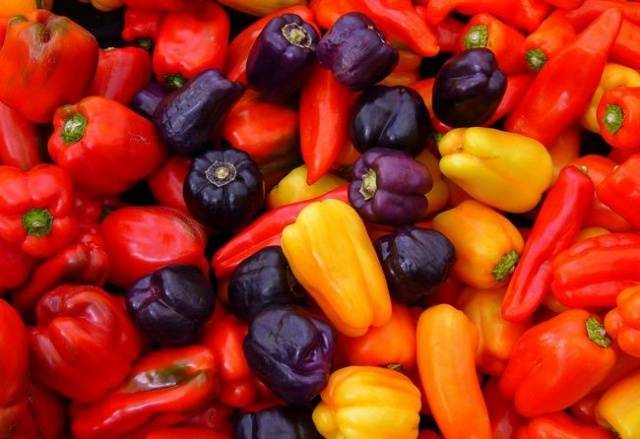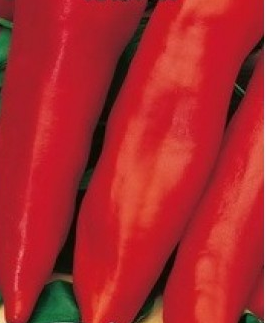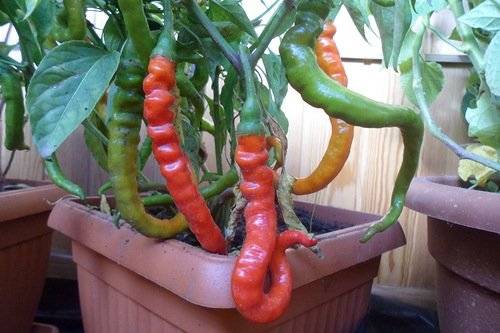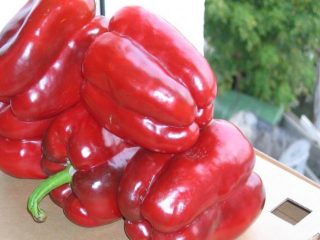Content
It is difficult to find a gardener who has never grown sweet peppers on his property. Despite his demanding conditions for care, he rightfully occupied his niche in our garden plots. sweet pepper Quite a lot has been released. All of them differ not only in their taste and color, but also in the shape of the fruit. In this article we will look at varieties of sweet peppers with long fruits.
Benefit
Sweet or bell peppers are so popular for a reason. All its demands on care are more than compensated by the benefits of its use. It contains the following vitamins and minerals:
- carotene;
- vitamin C;
- B vitamins;
- sodium;
- potassium;
- iron and others.
Due to its composition rich in vitamins and minerals, sweet peppers have a positive effect on the circulatory and nervous systems. Vitamin P, which is contained in this vegetable, will help maintain the elasticity of blood vessels and capillaries. This makes it especially useful in the prevention of atherosclerosis and thrombosis.In addition, it is used to prevent and treat the following diseases:
- depression;
- prostration;
- diabetes;
- osteoporosis and others.
It is better to refrain from its excessive use in case of hypertension, kidney and liver diseases, as well as diseases of the digestive system.
Characteristics of varieties
Breeders have developed a sufficient number of bell pepper varieties with long fruit shapes. We will consider the most popular varieties depending on their ripening time.
Early
Early varieties will be able to please the gardener with a harvest within 100 days from the moment of germination. They are perfect for both greenhouses and open ground.
Cockatoo F1
This hybrid variety is distinguished by the size of its fruits. Each of its peppers will be at least 25 cm long. Some specimens can grow up to 30 cm in length. The weight of the fruit will be about 500 grams. The thickness of their walls will not exceed 6 mm. The shape of the peppers resembles the elongated beak of a cockatoo bird. At biological maturity they are bright red. The pulp of the fruit is quite fleshy and very aromatic. It is perfect for canning.
You also need to monitor the number of fruits on each bush - there should be no more than 10 pieces.
Cockatoo F1 has good immunity to verticellosis, tobacco mosaic and blossom end rot. The yield of one plant of this hybrid will be about 3 kg.
Marconi
Powerful Marconi bushes have a height of up to 90 cm. They contain peppers shaped like an elongated cone. Their length will be about 22 cm, the weight will not exceed 200 grams, and the wall thickness will be 5 mm.Their color changes depending on their degree of maturity from green to red. The high commercial qualities of long Marconi peppers go well with their excellent taste. They have tender and juicy flesh.
Marconi is distinguished by its yield - up to 10 kg per square meter.
Orjen
A compact plant of this variety can grow up to 60 cm in height. The pepper is long in shape and slightly elongated. Its length will be about 24 cm, width 6 cm, and weight about 140 grams. The wall thickness of the Orien pepper will be 5 mm. The light yellow long fruits will turn bright red as they ripen. They have excellent taste and are ideal for cooking and canning.
The yield per square meter will be about 5 kg.
Sweet banana
Compact Sweet Banana pepper bushes grow up to 65 cm in height. After flowering ends, they are covered with light yellow fruits. When they reach biological maturity, the color changes to orange-red. The Sweet Banana variety is distinguished by the high quality of its fruits. The pepper is long - up to 17 cm and has the shape of a banana. Its weight will be about 250 grams, and the wall thickness will not exceed 8 cm. The pulp of the fruit is juicy and has a delicate aroma. It is perfect for both fresh consumption and canning.
Sweet banana has good resistance to many diseases, especially blossom end rot. Plant yield will be about 4 kg per square meter.
Average
Peppers of mid-season varieties can be harvested 110–120 days after emergence.
Red elephant
Semi-spreading, powerful Red Elephant bushes can grow up to 90 cm in height. They contain fruits in the shape of an elongated cone. Their surface has a strong glossy sheen. During the period of technical maturity they are colored green, and during the period of biological maturity they are dark red. Their length will not exceed 22 cm, and their weight will be about 150 grams. The wall thickness of the peppers will range from 4 to 5 mm. The pulp is quite juicy with a slight peppery aroma.
The yield of the Red Elephant will not exceed 7 kg per square meter.
Shepherd
This variety has bushes up to 50 cm in height. Its pepper is long - about 20 cm and weighs up to 250 grams. The thickness of the fetal wall will not exceed 9 mm. The Shepherd variety is valued among gardeners due to the original shape of its peppers. They look like an elongated cone with a slightly sharp tip. During the period of biological maturity, they are red in color. The pulp of its long fruits is sweet and very juicy. It is perfect for canning.
Shepherd has good resistance to pepper blight and tobacco mosaic virus.
Sugar cone
The variety is characterized by fairly powerful, vigorous bushes up to 60 cm in height. Its fruits grow up to 17 cm in length and weigh up to 135 grams. The wall thickness will be about 6 mm. They have a conical shape with slight ribbing. During the period of technical ripeness, the fruits are colored creamy-yellow, and during the period of biological ripeness, they are red. The thin skin of the Sugar Cone hides the tender, sweet and juicy flesh.
The value of this variety lies in its abundant fruiting over a long period of time.
Hottabych F1
The plants of this hybrid are quite spreading with a height of up to 1.5 meters. Their long fruits are shaped like a trunk.The weight of each of them will not exceed 100 grams, and the wall thickness will be about 6 mm. The light green color of long Hottabych F1 peppers changes from light green to pale yellow as they ripen. The pulp is very tender and sweet. It can retain its taste even after long-term storage.
Hottabych F1 is resistant to blossom end rot, and its yield will be about 7 kg per square meter.
Late
They are perfect for greenhouses and open ground in the southern regions. Fruiting of late-ripening varieties occurs 125-130 days after emergence.
Mammoth tusks F1
This hybrid variety can surprise even the most experienced gardener with its size. On its bushes up to 1 meter high, up to 12 fruits can form simultaneously. The pepper of this hybrid grows up to 27 cm in length and weighs 300 grams. Its green color gradually and unevenly changes to bright yellow and then to red. The pepper tastes sweet, with tender and juicy flesh. It is best consumed fresh, but it is also suitable for canning.
The yield of this hybrid variety is completely independent of the soil. In addition, its plants are resistant to tobacco mosaic.
Horn red
This variety has fairly spreading bushes with a height of up to 1 meter. Its elongated fruits, weighing up to 120 grams, have the shape of a cylinder with a sharp tip. During the period of biological maturity, their color becomes bright red. The variety is distinguished by its dense and very juicy pulp with a light peppery aroma.
Horn red has good resistance to many diseases.
Python
This variety has not only long fruits, but also long bushes - up to 1.5 meters in height. They are not very leafy and semi-spreading. The Python variety stands out noticeably among other varieties.Its peppers are long – up to 27 cm and weighing up to 60 grams. The thickness of its walls will not exceed 3 mm.
The color of Python's long fruits changes depending on their ripeness. Green unripe fruits gradually turn red and acquire a glossy shine. A distinctive feature of Python is the absence of bitterness in the pulp of peppers. They can be consumed at any stage of ripeness, both fresh and for cooking.
The yield will be 3.8 kg of plants per square meter.
Recommendations for cultivation
Pepper, like other crops of the nightshade family, is grown through seedlings. You can learn about its preparation from the video:
Seedlings planted in a permanent location require proper care. This is the only way to achieve a bountiful harvest of this crop. Care includes:
- Optimal temperature conditions. For normal growth, pepper plants require a temperature of at least 21 degrees. If pepper grows in a greenhouse, then it needs to be ventilated regularly, and even open the door in hot weather.
- Regular watering. It should be done no more than 2-3 times a week. For each plant you need to add 1 to 2 liters of water. To prevent the soil from drying out less between waterings, it can be mulched.
- Fertilizers. The frequency of fertilizing should not exceed 2 times a month. Good results are obtained by using slurry, bird droppings, wood ash, superphosphate and ammonium nitrate. The optimal time for feeding is in the morning from 8 to 11 o'clock.
For following the recommendations, the plants of this crop will reward the gardener with an excellent harvest.




















